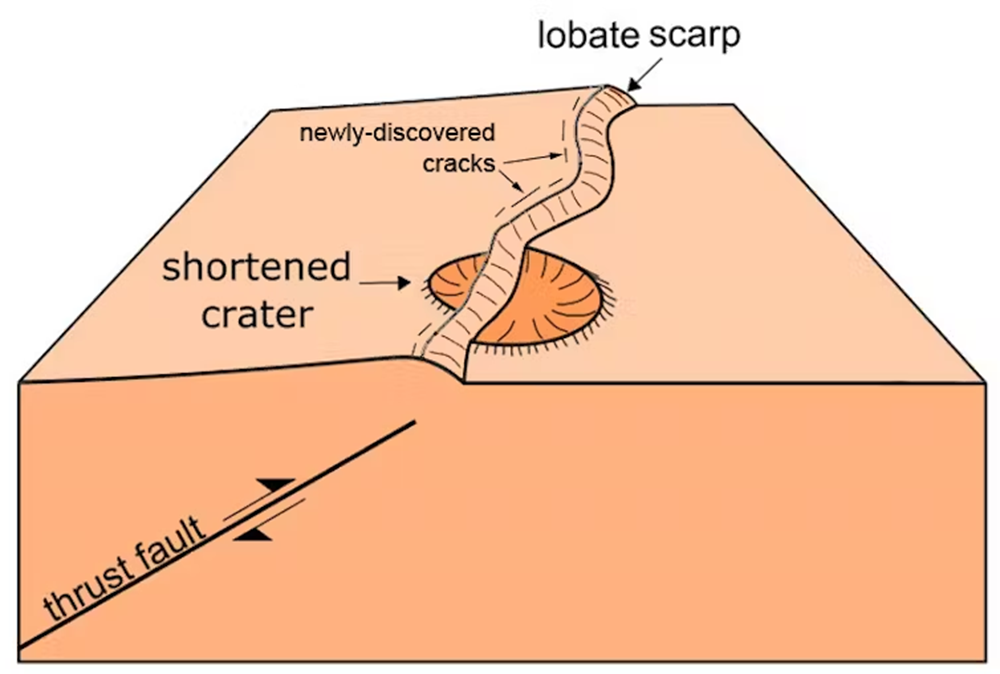When observing the various objects in our Solar System and beyond, scientists have found evidence that some of them appear to be shrinking. So what is going on, and is this happening to the Earth?
Mercury is shrinking
ADVERTISEMENT GO AD FREE
Back in 1974, NASA’s Mariner 10 mission flew by Mercury and discovered evidence that it, already the smallest planet in the Solar System, is shrinking. This evidence came in the form of kilometers-high slopes known as “scarps” all across the planet. These are caused by faults beneath the scarps called “thrusts” as the planet contracts due to thermal cooling.
“Because Mercury’s interior is shrinking, its surface (crust) has progressively less area to cover. It responds to this by developing ‘thrust faults’ – where one tract of terrain gets pushed over the adjacent terrain,” David Rothery, Professor of Planetary Geosciences at the Open University and author of a 2023 paper exploring the planet’s contraction, explained in a piece for The Conversation. “This is like the wrinkles that form on an apple as it ages, except that an apple shrinks because it is drying out whereas Mercury shrinks because of thermal contraction of its interior.”

Shortened craters are a sign of the planet’s contraction.
In 2014 it was estimated that the planet had contracted around 7 kilometers (4.4 miles). On Mercury, we can get a pretty good idea of when this shrinking happened by looking at the many impact craters that cover its surface. While some of the craters have become shortened by the planet’s contraction (shown in the above diagram), there are also craters on top of scarps, meaning that the impact that caused them happened after the fault shifted the planet’s crust.
From this, astronomers concluded the scarps were mostly around 3 billion years old. In the 2023 study, however, the team found evidence that the planet’s contraction isn’t over yet, as Mercury continues to cool down.
On these scarps, Open University PhD student Ben Man found “grabens”, where land had fallen down in between two faults, and a sign of stretching.
“Stretching may seem surprising on Mercury, where overall the crust is being compressed,” Rothery explained, “but Man realised that these grabens would occur if a thrust slice of crust has been bent as it is pushed over the adjacent terrain. If you try to bend a piece of toast, it may crack in a similar way.”
ADVERTISEMENT GO AD FREE
As these grabens had not been entirely covered by debris from impacts on Mercury, the team was able to estimate that the stretching and collapsing took place less than 300 million years ago, evidence that the contraction of the planet is still taking place today.
The Moon is shrinking
Back in 2010, astronomers looking at the geology of the Moon made the not entirely unexpected discovery that the Moon is also shrinking. Again looking at scarps, this time in images taken from cameras aboard Apollo 15, 16, and 17, the team found that the Moon has been contracting as it cools, and fairly recently to boot.
“One of the remarkable aspects of the lunar scarps is their apparent young age,” Tom Watters, a planetary scientist in the Center for Earth and Planetary Studies at the National Air and Space Museum, said in a statement at the time. “Relatively young, globally distributed thrust faults show recent contraction of the whole Moon, likely due to cooling of the lunar interior. The amount of contraction is estimated to be about 100 meters [328 feet] in the recent past.”
ADVERTISEMENT GO AD FREE
In 2019, analyzing data from a number of seismometers on the Moon by the Apollo program, scientists including Watters found further evidence that the Moon is continuing to get smaller.
“We think it’s very likely that these eight quakes were produced by faults slipping as stress built up when the lunar crust was compressed by global contraction and tidal forces, indicating that the Apollo seismometers recorded the shrinking Moon and the Moon is still tectonically active,” Watters said in a NASA statement.
“Our analysis gives the first evidence that these faults are still active and likely producing moonquakes today as the Moon continues to gradually cool and shrink.”
Is the Earth shrinking?
The Earth is a little more complicated than the Moon and Mercury due to its thicker atmosphere. The Earth does gain a little mass, as around 40,000 tonnes of material – dust and rock – falls to our planet every year. This is negligible, however, compared to the amount of gas lost from our atmosphere to space.
ADVERTISEMENT GO AD FREE
“Physicists have shown that the Earth is losing about three kilograms [6.6 pounds] of hydrogen gas every second. It’s about 95,000 tonnes of hydrogen that the planet is losing every year,” Dr Chris Smith, microbiologist and science communicator, explained to the BBC.
“The other very light gas this is happening to is helium and there is much less of that around, so it’s about 1,600 tonnes a year of helium that we lose.”
Balancing this and other factors, such as the core losing energy as it cools and the planet gaining a little energy due to climate change, Smith estimates that the Earth gets around 50,000 tonnes lighter every year. This sounds dramatic, but is a loss of around 0.000000000000001 percent of the planet’s overall mass.
Meanwhile, by using a number of techniques including satellite laser ranging with millimeter-level precision, scientists have determined that the Earth’s overall radius changes at about the rate of 0.1 millimeters (0.004 inches) per year, which is about the width of a human hair.
Source Link: The Moon Is Shrinking, Mercury Is Shrinking. Is The Earth?